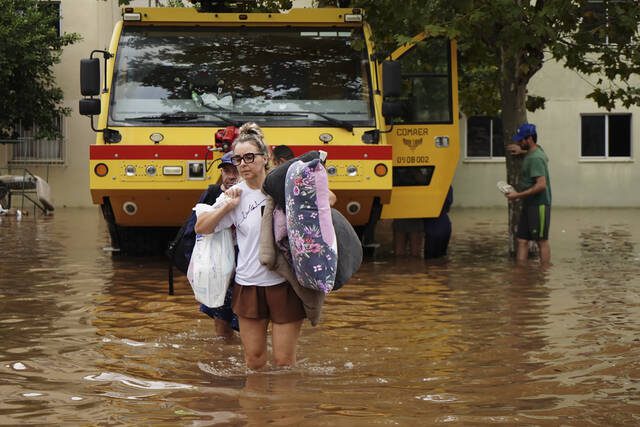Massive floods in the southern Brazilian state of Rio Grande do Sul have resulted in the deaths of at least 75 individuals in the past seven days, with 103 others reported as missing, according to local authorities on Sunday.
There were at least 155 injuries, and the rains have led to the displacement of over 88,000 individuals from their residences. Around 16,000 sought shelter in schools, gyms, and other temporary locations.
The floods caused widespread destruction, including landslides, washed-out roads, and collapsed bridges throughout the state. Power and communication outages were reported by operators. The civil defense agency cited data from water company Corsan, stating that over 800,000 people are currently without access to water.
In the Bento Gonçalves municipality, a rescue team airlifted an elderly man in critical condition from a remote area, as shown in footage from military firefighters. Brown water poured over a nearby dam in torrents.
Residents of the town of Canoas formed a human chain in muddy water, standing up to their shoulders and pulling boats to safety in a video shared by local UOL news network on Saturday evening.
At 8 a.m. local time on Sunday, the Guaiba river reached a record level of 5.33 meters (17.5 feet), surpassing the levels seen during the historic 1941 deluge when the river reached 4.76 meters.
State Gov. Eduardo Leite stated on Sunday morning, “I repeat and insist: the devastation we are facing is unparalleled.” He previously indicated that the state will require a reconstruction effort akin to a “Marshall Plan.”
Brazilian President Luiz Inácio Lula da Silva, along with Defense Minister José Múcio, Finance Minister Fernando Haddad, and Environment Minister Marina Silva, visited Rio Grande do Sul for a second time on Sunday. The leftist leader and his team surveyed the flooded streets of Porto Alegre from a helicopter.
Lula told journalists after the visit, “We need to anticipate potential disasters and take action, rather than merely reacting to them.”
Pope Francis, during Sunday mass at the Vatican, expressed his prayers for the population of the state, saying, “May the Lord welcome the deceased and provide comfort to their families and those who have been displaced from their homes.”
The downpour began on Monday and was expected to continue until Sunday. In certain areas, such as valleys, mountain slopes, and urban areas, over 300 millimeters (11.8 inches) of rain fell within a week, as reported by Brazil’s National Institute of Meteorology on Thursday.
This is the fourth environmental disaster in the state within a year, following floods in July, September, and November 2023 which resulted in the deaths of 75 individuals.
The climate phenomenon El Niño, which warms surface waters in the Equatorial Pacific region, affects the weather across South America. In Brazil, El Niño historically causes droughts in the north and heavy rainfall in the south.
This year, the impacts of El Niño have been particularly significant, with a historic drought in the Amazon. Scientists state that human-caused climate change is leading to more frequent occurrences of extreme weather.
Suely Araújo, a public policy coordinator at the Climate Observatory, a network of many environmental and social groups, said that these tragedies will continue to occur, becoming increasingly worse and more frequent.
She stated on Friday that Brazil needs to adapt to the effects of climate change, referring to a process known as adaptation.



